There’s nothing more fun than creating your own little world and watching it thrive.
If you’re reading this, it means you already own a terrarium, or you’re planning to create one soon and need some guidance on what to do next.
It’s important to note that the choices you make are far from trivial, and terrarium building is more than a casual hobby. In fact, some universities, like Utah, even offer courses on the subject!
So let’s roll up our sleeves and delve into the fantastic world of terrarium mosses.
Why Moss in Terrarium?
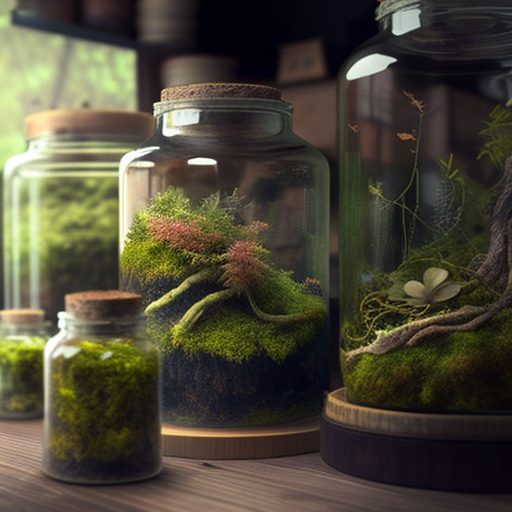
Moss plays a vital role in terrariums, not just for its appealing appearance but also for creating a healthy microclimate and providing nutrition for any animals that may be living in the environment.
In this guide, I’ll show you which mosses are best for terrariums and which one to choose for your DIY terrarium. Plus, you’ll see how to grow, propagate and care for moss.
There are over 12,000 different types of moss (if you want to have fun on the University of North Texas website, you can find the complete archive), so you don’t want to rely on chance in your choice.
First, you need to know that although there are many types of moss, not all of them are suitable for terrariums, and the absolute best one will depend on the specific conditions and preferences of your terrarium for you.
Go in a hurry? In this table, you will find a summary of the best mosses for terrariums. Read on for more info.
| Name | Scientific Name | Type | Perfect For | Popularity in terrariums |
| Java Moss | Taxiphyllum barbieri | Aquatic moss | Perfect for terrariums with aquatic parts or high humidity. | High |
| Pincushion moss | Leucobryum glaucum | Terrestrial moss | Suitable for all terrariums. Perfect for beginners. | Medium |
| Mood moss | dichronym scoparium | Terrestrial moss | Perfect for high maintenance terrariums. | Medium |
| Haircap moss | Polystichum formosum | Terrestrial moss | Suitable for terrariums where height development is required. | Low |
| Sphagnum moss | Sphagnum | Terrestrial moss | Excellent for creating a microclimate. | High |
| Fork moss | Dicranum scoparium | Terrestrial moss | Perfect in terrarium backgrounds. | Low |
| Spear-moss | Calliergonella cuspidata | Terrestrial moss | Perfect for enclosed terrariums. | Low |
| Tamarisk-moss “Fern Moss” | Thuidium delicatulum | Terrestrial moss | Perfect for terrariums with aquatic parts. | Medium |
| Christmas Moss | Vesicularia montagnei | Aquatic moss | Perfect for terrariums with aquatic parts or high humidity. | High |
Before starting, Live, Preserved, or Dried Moss?

Before seeing the suitable types of moss, a small premise and distinction must be made.
In fact, in our terrariums, we can insert both live mosses and preserved or dried moss.
There are pros and cons to using each of these types of moss in a terrarium.
Live moss is the most natural and attractive option and can also help regulate humidity levels and provide a natural habitat for small animals. However, it requires more maintenance than preserved or dried moss, as it needs regular watering, temperatures, light exposure, humidity levels, etc., and it may turn brown.
Preserved moss is a good option for those who want a low-maintenance option. It has been treated to preserve its natural color and texture and does not need to be watered or trimmed. However, it is not very attractive for certain types of terrariums where the living and micro-climatic components are the masters.
Dried moss falls somewhere between the previous two solutions and is another low-maintenance option, as it doesn’t need to be watered or trimmed. It will tend to lose its color over time, but the interesting aspect is that it can be “reactivated,” Therefore, it is possible to grow and propagate it at will.
Ultimately, the best type of moss for your terrarium will depend on your personal preferences and the specific needs of your terrarium. Live moss may be your best choice if you want an attractive, natural option that requires some upkeep. If you want a low-maintenance option requiring minimal care, preserved or dried moss may be better.
Terrestrial, Aquatic, or Air Mosses?
In the analysis of the best mosses for terrariums, it is good to divide them into three categories, terrestrial mosses, aquatic mosses, and aerial mosses.
If you plan to use stabilized or dried moss, the choice will be purely aesthetic, but if you plan to use live moss instead, then it is good to know the pros and cons of the various types.
Terrestrial moss
Terrestrial moss is simply moss that grows on earth. It is generally the best choice for terrariums.
Pros of Terrestrial Moss:
It can be easily purchased from moss suppliers
It can thrive in a variety of terrarium environments
It can help regulate humidity levels
Provides a natural habitat for small animals
Cons of Terrestrial moss:
It may require more maintenance, such as regular watering and pruning.
Aquatic Moss
Aquatic moss is the moss that grows in water, some mosses can grow both underwater and out of the water, and while purely aquatic mosses are generally great for aquariums, mosses such as Java Moss are used for terrariums or Christmas moss that can grow and survive both underwater and overwater.
Pros of Aquatic Moss:
It can be easily purchased from aquarium suppliers
It can thrive in humid environments
It can help regulate humidity levels
Cons of Water Moss:
It may not be suitable for all terrarium environments
Not all survive well out of the water.
Aerial Moss
Aerial moss, also known as epiphytic moss, is not true and can hook onto any structure due to the absence of roots. The moss grows on other plants or objects and gets its nutrients from the air and water rather than the soil.
Pros of Aerial Moss:
It can add visual interest and diversity to a terrarium
It can thrive in a variety of terrarium environments
Requires no soil or water for growth
Cons of air moss:
It may be more difficult to find and purchase
It may require more maintenance, such as regular misting and trimming
May not survive in closed terrariums.
The Best types of Mosses for Terrariums

Java Moss (Taxiphyllum barbieri)
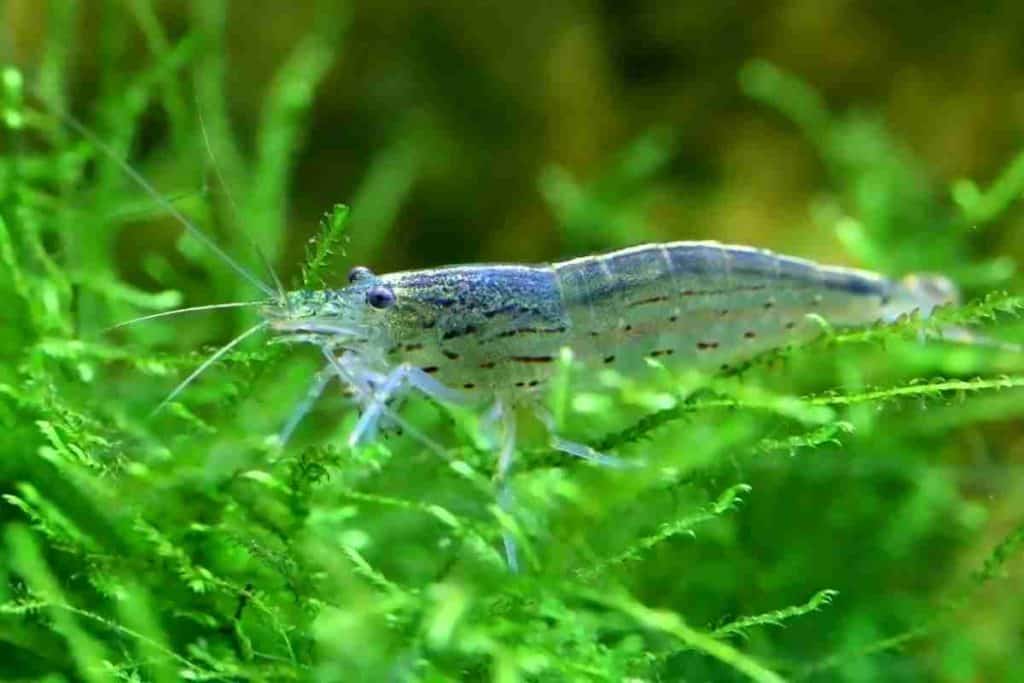
This is an aquatic moss that lives both underwater and above water. It is one of the most popular choices for both aquariums and terrariums. Versatile and durable, the secret to keeping it healthy and thriving is to maintain good airflow along with high humidity and frequent hydration.
It grows quickly underwater and is the perfect choice for those terrariums that include an aquatic part as the Paludariums.
It is also widely used because it grows on practically everything, therefore suitable for various configurations with rock, wood, glass, and plastic.
You will hardly find it around if you don’t live in Southeast Asia, but you can buy it online and then propagate it in your vivarium.
Pincushion moss (Leucobryum glaucum)
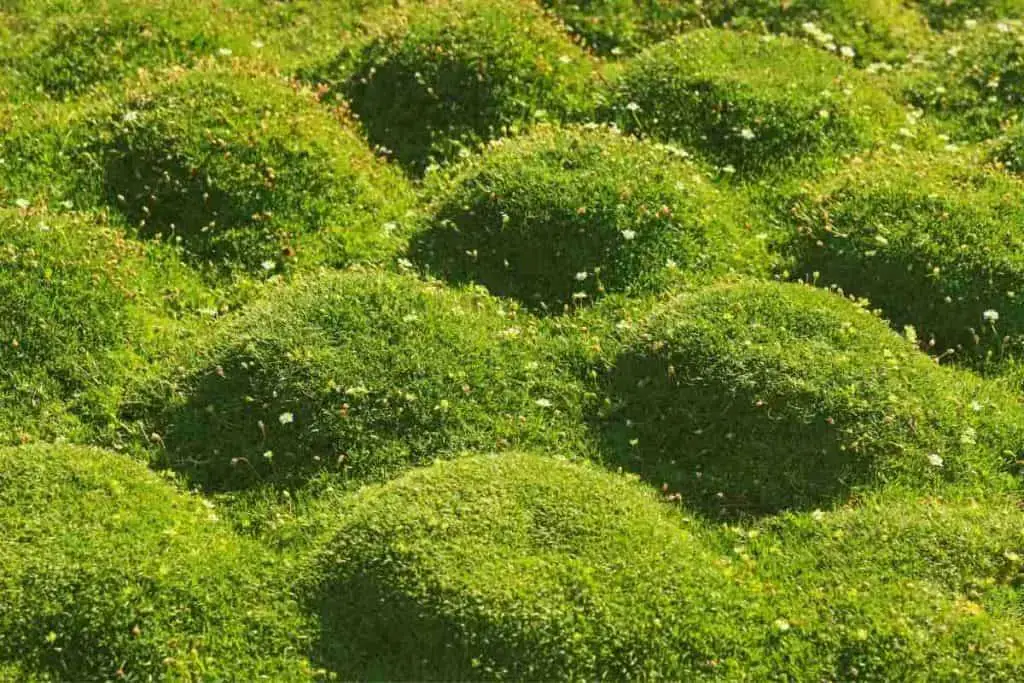
We are facing one of the best mosses ever to be used in terrariums.
If placed in the right conditions, which are then quite typical for a terrarium as moderate light, not too hot and humid, it will thrive beautifully.
Its uniform appearance makes it look almost artificial and forms these sorts of cushions that are extremely pleasing to the eye.
It is one of my favorites because it requires very little attention; indeed, you can also allow yourself the luxury of treating it badly because it will only need to be rehydrated to return to its usual brilliant, fantastic green.
Simple to model and adapt, I recommend it to everyone but especially to beginners.
Mood moss (dichronym scoparium )
It is a very simple moss and is well appreciated by those who use it in terrariums. Its appearance makes it look like grass brushed by the wind and creates that landscape dynamism much appreciated in terrariums.
Indirect sunlight, like all mosses, and above all, keep it hydrated. Mood Moss is delicate and turns yellow quickly if it lacks the right degree of humidity, but be careful; you must keep it moist and not saturated with water.
Haircap moss (polytrichum formosum)
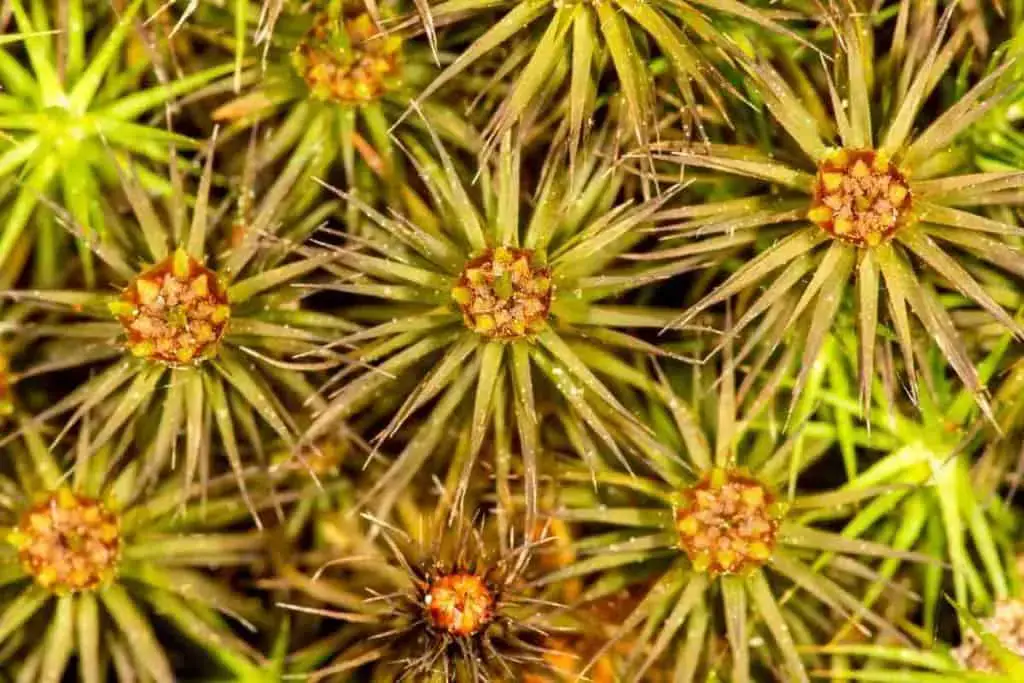
This type of moss is really beautiful and particularly with its star shape that develops into cushions even several inches high.
The visual impact is high and is the main reason for its use in terrariums. The care it requires is the usual of all mosses without major exceptions. I have to note that every now and then, she needs to remove some parts that turn brown, and therefore she needs a good haircut.
sphagnum moss or Peat moss (Sphagnum)

This moss is one of the best for the terrarium but is not usually chosen for its aesthetic qualities but for its properties.
Its fungal and decomposition inhibitory properties make it a good candidate for terrariums of all kinds. It absorbs and holds moisture well and is an excellent means of supplying the right acidity and nutrients to the rest of the terrarium. It grows and propagates easily, and it provides fertilizer for the terrarium when it decomposes.
Excellent moss, therefore, for those who want to recreate a life cycle in perfect harmony within their own moss. To maintain it, keep the humidity high in the terrarium.
fork moss (Dicranum scoparium)
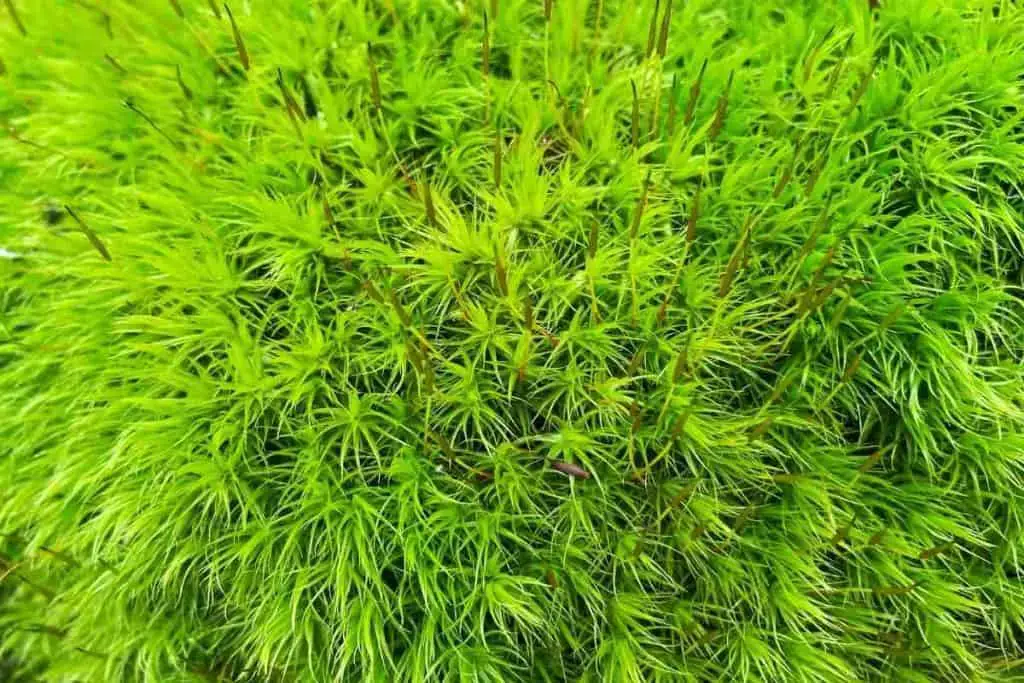
Fork moss is another beautiful and perfect moss for terrariums. Its high aesthetic makes it the ideal candidate to create backgrounds in small terrariums or, in any case, as an aesthetic impact even in larger terrariums; it manages to give the right accent.
It is a low maintenance moss, and this is another factor to consider when choosing. So if you are creating a small terrarium or if you want an aesthetic variation, this moss is for you.
Spear-moss (Calliergonella cuspidata)
This moss is perfect for those terrariums where you want to use a modest amount. I say this because it has a dark green color that stands out well from the others and creates contrast within the colors of the terrarium, but if it meets your taste, you can use it en masse. It does not require a lot of humidity and remains beautiful green even with little maintenance. These qualities make it a good candidate for use in closed terrariums.
Tamarisk-moss “Fern Moss” (Thuidium delicatulum)
Tamarisk musk gets its name from the resemblance to the leaves of the tamarisk tree. It is part of the fern moss family or those mosses that are similar to ferns and have curved roots typical of ferns.
This moss is also often used in aquariums, but be careful as it is a terrestrial moss and does not thrive fully submerged. At the same time, it’s perfect for those terrariums that feature waterways like small waterfalls, etc., because you can live and thrive even when it’s very wet. It can therefore be placed on the edges or in the passage points where the splashes wet it, creating a magical effect in our terrarium.
Christmas Moss (Vesicularia montagnei)
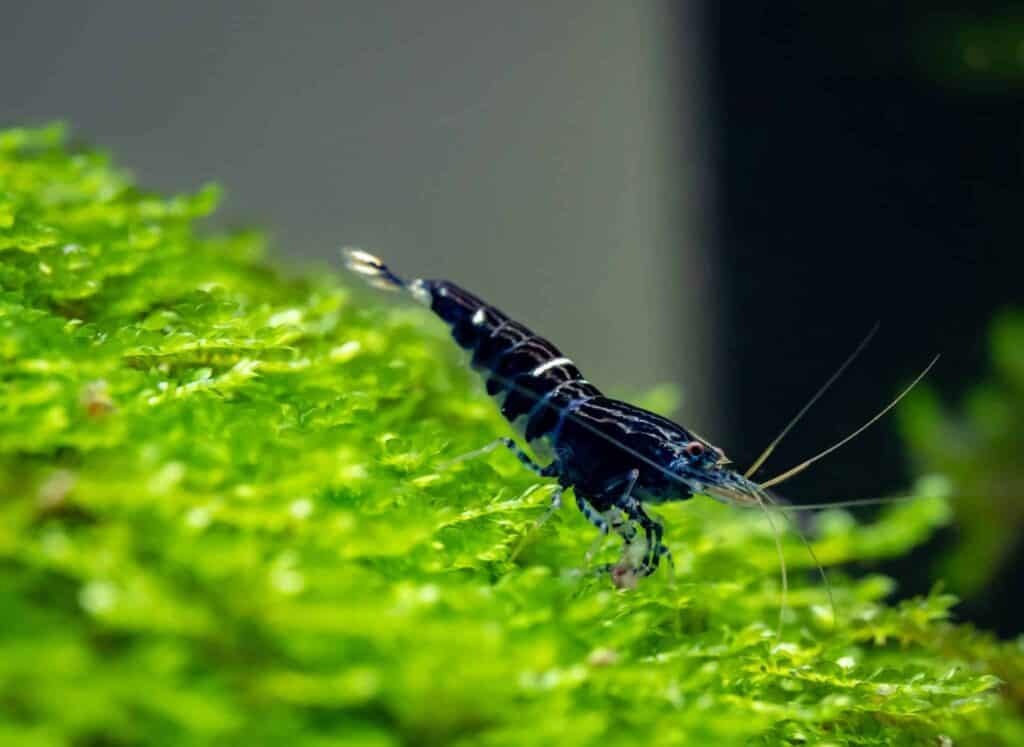
Speaking of mosses that look like something else, I present to you the Christmas moss that has this name for two fundamental reasons: its spores look like a fir tree, and it grows during Christmas. I gladly include this moss among the best for terrariums. Like java moss, it is versatile and can grow out of the water and completely submerged. It also sticks very well to various surfaces, such as limestone or lava rocks. If you grow it on a rock, you can move it in or out of the water at will; really useful and nice to look at.
Requires lots of indirect light, humidity, and water (preferably distilled).
If it turns yellow or brown you can follow this useful guide:
What to do if your Christmas moss turns brown or yellow?
Honorable mention.
Marimo Moss Ball
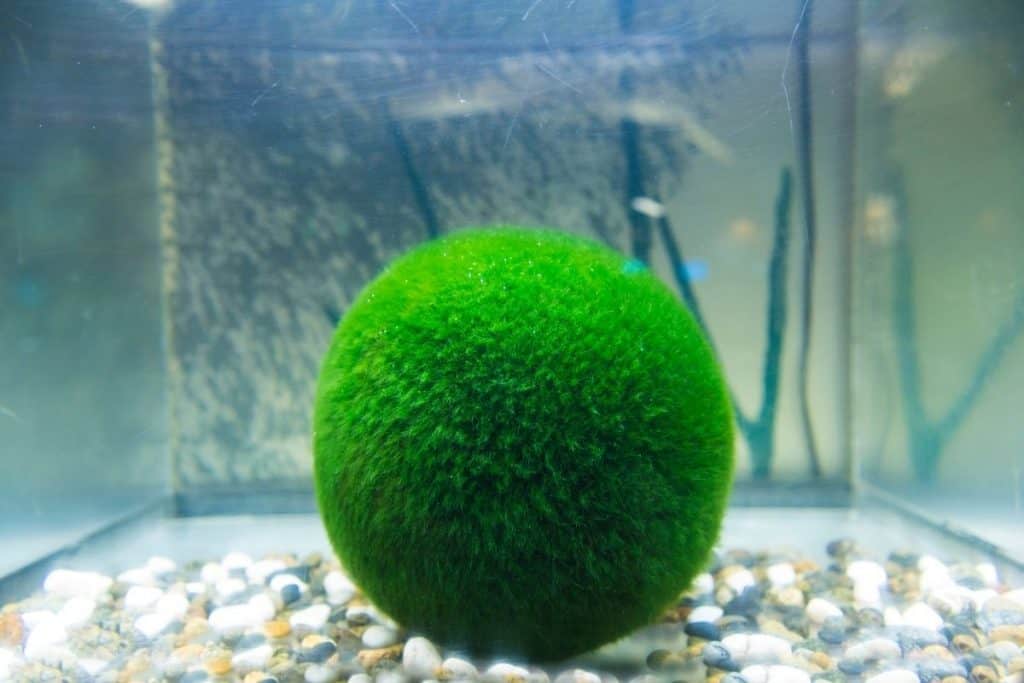
Although the moss ball is highly sought after in terrariums, it is not among the best mosses for terrariums because this type of moss is not used as a complement in a terrarium but as the main attraction and often constitutes the only form of life present. It is also found in aquariums, but it isn’t a very appropriate use. To be really picky, it would therefore be more of a mossarium than a terrarium, but the fact is that I could not fail to mention this beautiful species of moss.
So, yes, you can use the Marimo moss ball in your small terrarium, usually in a small jar no bigger than a jam jar; you can store one or more moss balls and insert decorations or a pebble base at the bottom. The Marimo moss ball is a sea moss that lives underwater, and its care is effortless. Just remember to change the water once a week to ensure its health.
Where to buy the best moss for terrariums?
Convinced! Well, now you must be wondering where you can buy these beautiful mosses for your terrarium. You’re lucky; you’ve been given various choices, all of which are very good. My favorite places to buy discount moss to use in terrariums are:
– Etsy (best variety of choice, you can find good quality)
– Amazon (great for deals, doesn’t always have all the variety you need)
There are also other alternatives, such as aquarium sites, where sometimes viable choices can be found. However, on Etsy in particular, but also on Amazon, I can find the variety and quality I’m looking for with some confidence.
One last consideration
As you can imagine, out of a list of over 12,000 types of mosses, it is impossible to test them all in our terrariums, and the choices also vary according to personal tastes. The list of the best mosses I have selected not only satisfies my taste but embraces the most used mosses ever in the creation of terrariums or mossariums (they are terrariums exclusively dedicated to moss). If you have any doubts or if there are types of moss that you deem more suitable for building terrariums, you can write to me freely; I will happily accept your suggestions.